The human iris contains intricate patterns as unique as fingerprints. Iridology charts map these patterns to different body systems, creating a fascinating window into potential health conditions. This comprehensive guide explores how practitioners use iridology chart, their historical origins, and the ongoing debate about their effectiveness in alternative medicine.

Che cos'è una tabella iridologica?
UN grafico iridologico serves as a detailed map that divides the iris into zones, each corresponding to different organs and systems within the body. Practitioners use these charts to analyze the color, texture, and markings in your iris to identify potential health imbalances before they manifest as physical symptoms.
A standard iridology chart mapping iris zones to corresponding body systems
These specialized charts provide a framework for iridologists to interpret what they observe in your eyes. While conventional medicine remains skeptical, proponents believe these charts offer insights into your body’s strengths, weaknesses, and potential health concerns.
The Historical Origins of Iridology Charts
The practice of examining the iris for health insights dates back thousands of years, with roots in ancient Egypt, China, and India. However, modern iridology charts emerged in the 19th century through the work of Hungarian physician Ignatz von Peczely.

Ignatz von Peczely, considered the father of modern iridology
As a child, von Peczely noticed changes in an owl’s iris after the bird suffered a broken leg. This observation sparked his lifelong study of the connection between iris markings and physical health. In 1880, he published the first comprehensive iridology chart, mapping specific iris zones to organs and body systems.
Throughout the 20th century, practitioners like Bernard Jensen further refined these charts, creating the detailed mapping systems used by modern iridologists today. These evolving charts reflect decades of observation and documentation by alternative health practitioners.
Key Components of an Iridology Chart
Understanding how to read an grafico iridologico requires familiarity with its fundamental components. Each chart typically divides the iris into concentric zones and radial sections, creating a comprehensive map of the body.

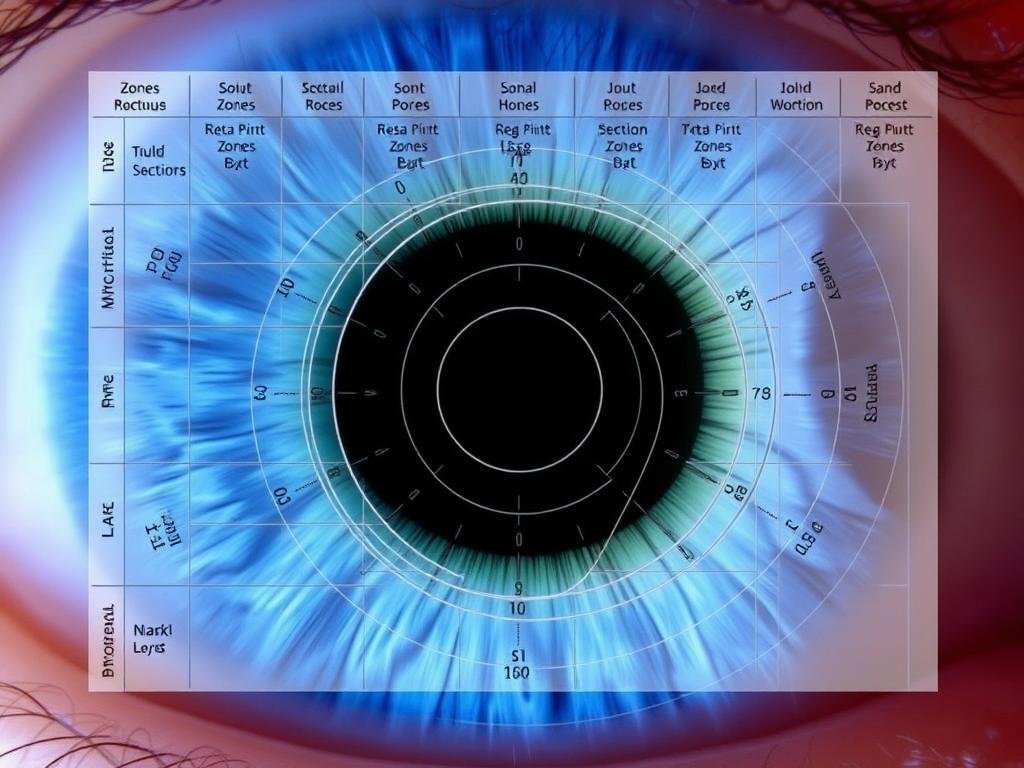
Iridology chart overlay on a human iris showing mapping zones
Primary Sections of an Iridology Chart
- Zona pupillare – The area immediately surrounding the pupil, associated with the digestive system and stomach
- Collarette/Autonomic Nerve Wreath – The jagged boundary separating the pupillary zone from the ciliary zone, representing the autonomic nervous system
- Zona ciliare – The middle area of the iris, containing markings related to most organs and tissues
- Iris Edge/Periphery – The outer rim of the iris, associated with the skin, lymphatic system, and circulation
- Radial Zones – Pie-shaped sections extending from the pupil to the edge, each linked to specific organs
- Lacune – Closed, often darkened areas indicating potential inherent weaknesses
- Cripte – Open, usually lighter areas suggesting acute conditions
Each iris is further divided into approximately 60 sectors corresponding to different body parts. The right iris generally reflects the right side of the body, while the left iris corresponds to the left side.
Right and Left Iris Interpretation
Iridology charts typically show different mappings for the right and left iris, as each is believed to correspond to different sides and systems of the body.


Right iris chart mapping
Right Iris Correlations
- Brain and right side of head
- Right lung and bronchi
- Liver and gallbladder
- Right kidney
- Ascending and transverse colon
- Organi riproduttivi giusti
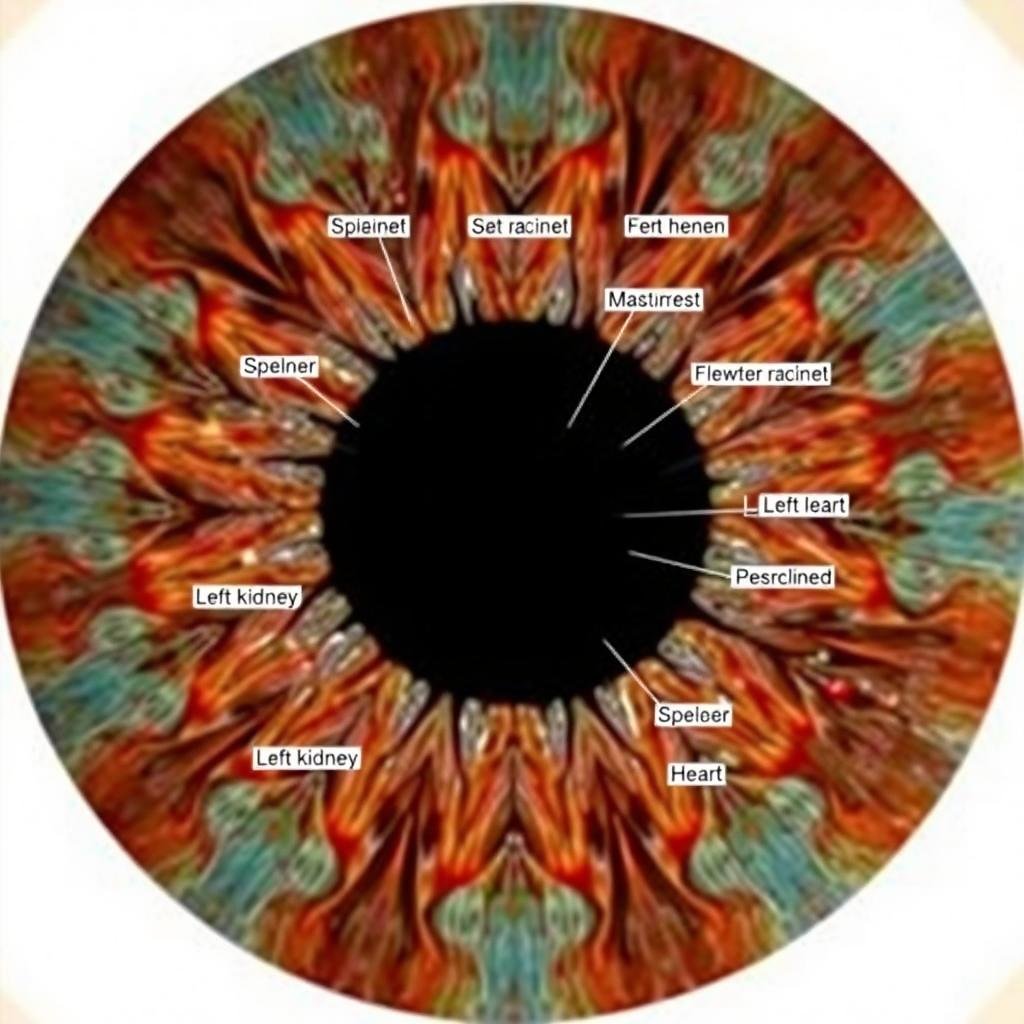
Left iris chart mapping
Left Iris Correlations
- Left side of brain and head
- Heart and left lung
- Stomach and spleen
- Rene sinistro
- Colon discendente
- Left reproductive organs
Practitioners analyze both irises together to form a complete picture of the body’s health status. Asymmetries between the eyes may indicate imbalances requiring attention.
To make diagnosis more accurate, grafico iridologico is often use in conjunction with other diagnostic methods.

Iridology Chart Right Eye -Iridology Chart – Right Eye
right eye riflette right side corpo.
| Clock Position (Right Eye) |
Corrisponde all'organo/sistema |
Dettagli |
| 1 in punto - 2 in punto |
Right Face |
Corresponds to left reproductive organs, include uterus, ovaries (female) or testes (male). |
| 2 in punto - 3 |
Right Throat
|
Ringflects health left joints, include knees, hips, elbows, and shoulders. |
| 3 - 4 in punto |
Right UPPER BACK
|
Corresponds to spine, spinal health, alignment, and flexibility. |
| 4 in punto - 5 in punto |
Right Bladder |
Ringflects bladder and right side urinary system. |
| 5 - 6 in punto |
Right PELVIC |
Ringpresents left colon, small intestine, and digestive health. |
| 6 in punto - 7 |
Right LOWER ABDOMEN
|
Ringflects left kidney, focuse on filtration, detoxification, and fluid balance. |
| 7 - 8 in punto |
Right UPPER ABDOMEN
|
Ringflects stomach and digestive organs on left side. |
| 8 in punto - 9 |
Right THORAX |
Corresponds to left side liver, responsible detoxification and bile production. |
| 9 in punto - 10 |
Right LUNG |
Ringpresents left side heart, affecte cardiovascular health and circulation. |
| 10 - 11 |
Right NECK |
Ringflects left lung, respiratory health, and brea function. |
| 11: 12 |
Right Brain
|
Corresponds to left hemisphere brain, mental health, and cognitive functions. |
| 12 - 1 in punto |
Right Brain
|
Corresponds to left hemisphere brain, mental health, and cognitive functions. |
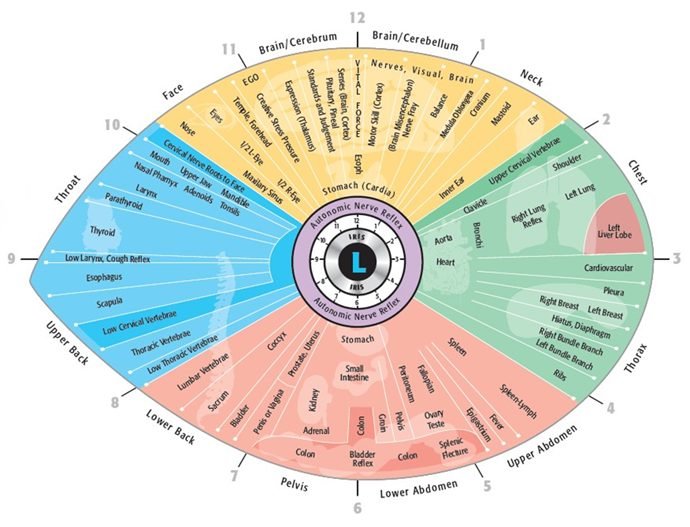
Grafico IRIDOLOGIA Sinistra Eye - Chart Iridology - Sinistra Eye
occhio sinistro riflette lato sinistro corpo.
| Posizione dell'orologio (occhio sinistro) |
Corrisponde all'organo/sistema |
Dettagli |
| 1 in punto - 2 in punto |
Collo sinistro
|
Corrisponde agli organi riproduttivi a destra, includono utero, ovaie (femmine) o testicoli (maschio). |
| 2 in punto - 3 |
Sinistro |
Ringflects Health Right Joins, includono ginocchia, fianchi, gomiti e spalle. |
| 3 - 4 in punto |
Ha lasciato il torace |
Corrisponde a colonna vertebrale, salute spinale, allineamento e flessibilità sul lato destro. |
| 4 in punto - 5 in punto |
Addome superiore sinistro
|
Ringects vescica e sistema urinario sul lato sinistro. |
| 5 - 6 in punto |
Addome inferiore sinistro
|
Ringpresenti a destra del colon, dell'intestino tenue e della salute digestiva. |
| 6 in punto - 7 |
Sinistro pelvico
|
Ringects rene destro, focalizzato su filtrazione, disintossicazione e bilanciamento dei fluidi. |
| 7 - 8 in punto |
Sinistra la parte bassa della schiena
|
Ringetta lo stomaco e gli organi digestivi sul lato destro. |
| 8 in punto - 9 |
La parte superiore della parte superiore sinistra
|
Corrisponde al fegato laterale destro, alla disintossicazione responsabile e alla produzione biliare. |
| 9 in punto - 10 |
La gola sinistra
|
Ringpresents Heart Right Heart, influisce sulla salute e la circolazione cardiovascolare. |
| 10 - 11 |
Faccia sinistra |
Ringetta il polmone destro, la salute respiratoria e la funzione Brea. |
| 11: 12 |
Cerebrum sinistro |
Corrisponde al cervello dell'emisfero destro, alla salute mentale e alle funzioni cognitive. |
| 12 - 1 in punto |
Cerebrum sinistro |
Corrisponde al cervello dell'emisfero destro, alla salute mentale e alle funzioni cognitive. |
- Right Eye: Ringflects Right side body (e.g., Right kidney, Right lung, Right reproductive organs, etc.).
- Left Eye: Ringflects Left side body (e.g., Left kidney, Left lung, Left reproductive organs, etc.).
Interpreting Iris Colors and Markings
Beyond the zonal mapping, iridology charts include guidelines for interpreting various colors, textures, and markings found in the iris. These features provide additional layers of information about potential health conditions.
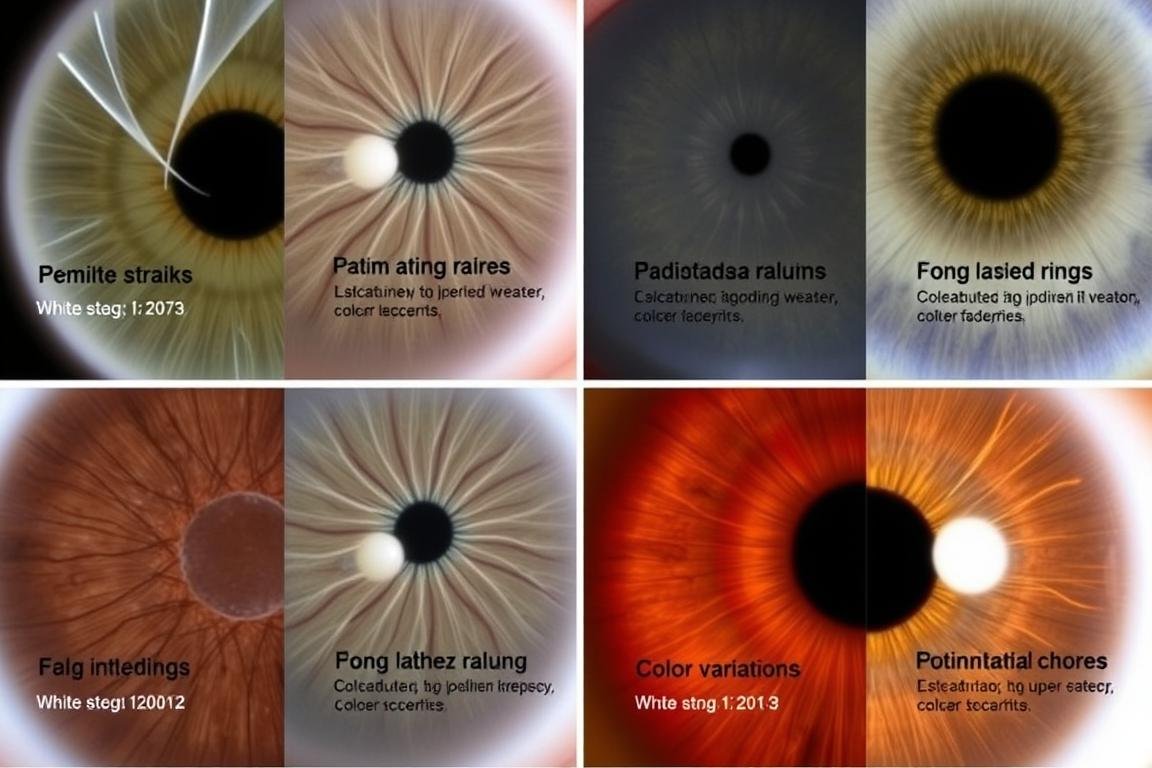
Common iris markings and their interpretations in iridology
Segni comuni dell'iride e loro significati
| Funzione Iris |
Aspetto |
Potenziale indicazione |
| White Rings |
Linee bianche circolari intorno all'iride |
Possible high cholesterol or arterial tension |
| Macchie scure |
Brown or black flecks |
Potential toxin accumulation or organ damage |
| Radial Lines |
Lines extending from pupil to iris edge |
Nerve stress or circulation issues |
| Yellow Tint |
Scolorimento giallastro |
Possible kidney or liver stress |
| Lacune |
Closed, dark, often oval areas |
Inherent weakness in corresponding organ |
| Rosario linfatico |
White dots forming a circle |
Congestione del sistema linfatico |
Iris color also plays a significant role in iridology analysis. Blue irises (lymphatic constitution) may indicate different tendencies than brown irises (hematogenic constitution) or mixed irises (biliary constitution).
How to Use an Iridology Chart at Home
While professional iridology requires training and experience, you can perform basic iris observation at home. This preliminary self-assessment might spark insights worth discussing with a qualified practitioner.
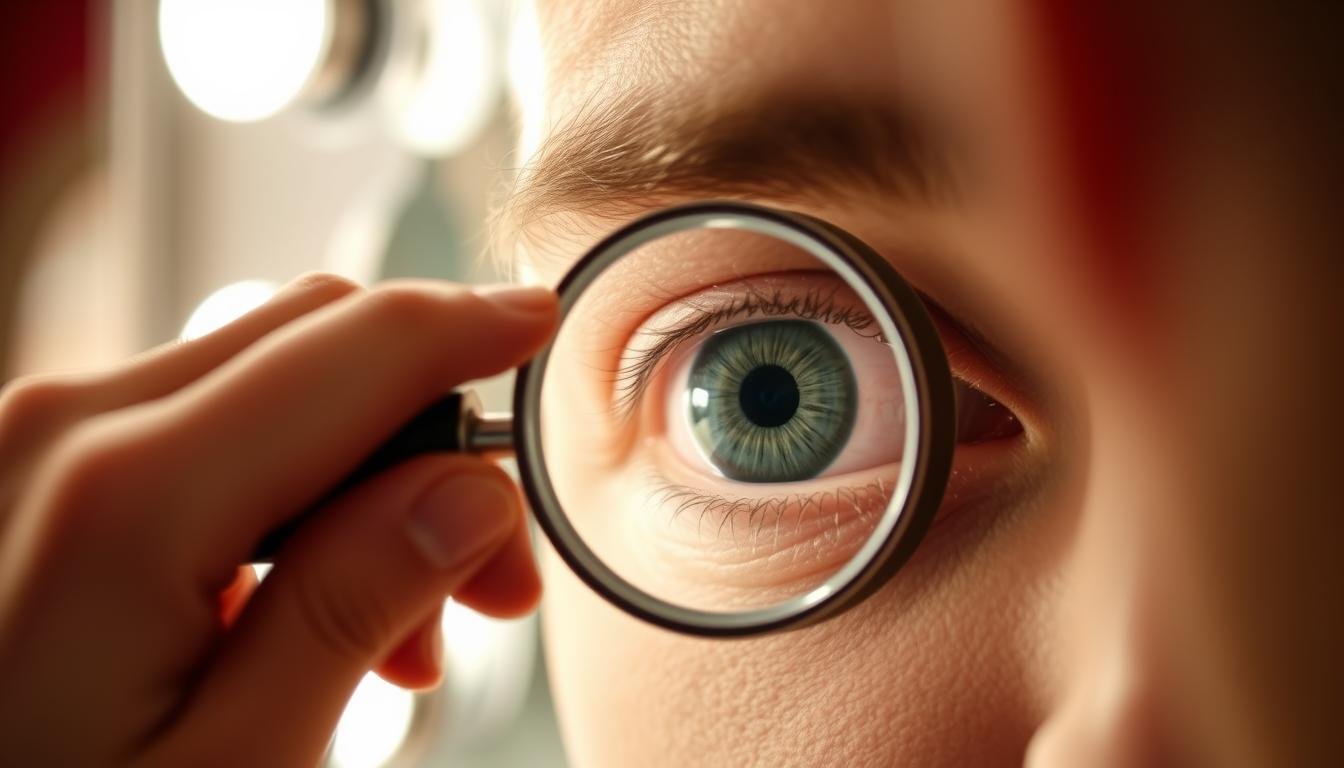
Basic self-examination using proper lighting and magnification
Steps for Basic Iris Self-Examination
- Gather equipment: A small flashlight, magnifying glass, and mirror in a well-lit area
- Position lighting: Place the light source at a 45-degree angle to your eye to avoid reflections
- Examine each iris: Look for color variations, markings, rings, and spots
- Compare with a chart: Reference a basic iridology chart to understand what you’re seeing
- Document observations: Take notes or photos to track changes over time
- Consult a professional: Share your observations with a trained iridologist for proper interpretation
Want to Learn More About Iris Analysis?
Download our comprehensive iridology chart reference guide to start your journey into understanding what your eyes might reveal about your health.
Download Free Iridology Chart Guide
Remember that self-assessment is merely educational and should not replace professional medical advice or diagnosis from qualified healthcare providers.
Health Conditions Iridology Claims to Detect
Practitioners of iridology believe that various markings and patterns in the iris can indicate potential health issues in corresponding body systems. While scientific evidence remains limited, these are some conditions that iridologists commonly claim to identify through iris analysis.

Iridology mapping of common health conditions to iris regions
Sistema digestivo
- Intestinal inflammation
- Stomach acidity issues
- Malabsorption concerns
Sistema circolatorio
- Blood pressure tendencies
- Circulation efficiency
- Cholesterol indications
Elimination Systems
- Kidney and bladder stress
- Liver congestion
- Lymphatic system stagnation
Iridologists emphasize that these indications represent tendencies or predispositions rather than definitive diagnoses. The iris may show constitutional weaknesses that could develop into health issues if not addressed through lifestyle modifications.
Curious About What Your Iris Reveals?
Connect with a certified iridology practitioner for a personalized analysis of your iris patterns and what they might indicate about your health tendencies.
Trova un iridologo vicino a te
The Scientific Perspective on Iridology
While iridology has passionate advocates, it’s important to understand the scientific community’s perspective. Conventional medicine has conducted several controlled studies examining iridology’s diagnostic claims with mixed results.
I sostenitori sostengono
- The iris contains over 28,000 nerve fibers connected to the brain
- Anecdotal success stories support its effectiveness
- It offers a non-invasive approach to health assessment
- It may detect imbalances before symptoms appear
I critici sottolineano
- Limited peer-reviewed research supports its claims
- Controlled studies show inconsistent diagnostic accuracy
- I modelli di iris sono in gran parte determinati dalla genetica
- Potential delay in seeking conventional medical treatment
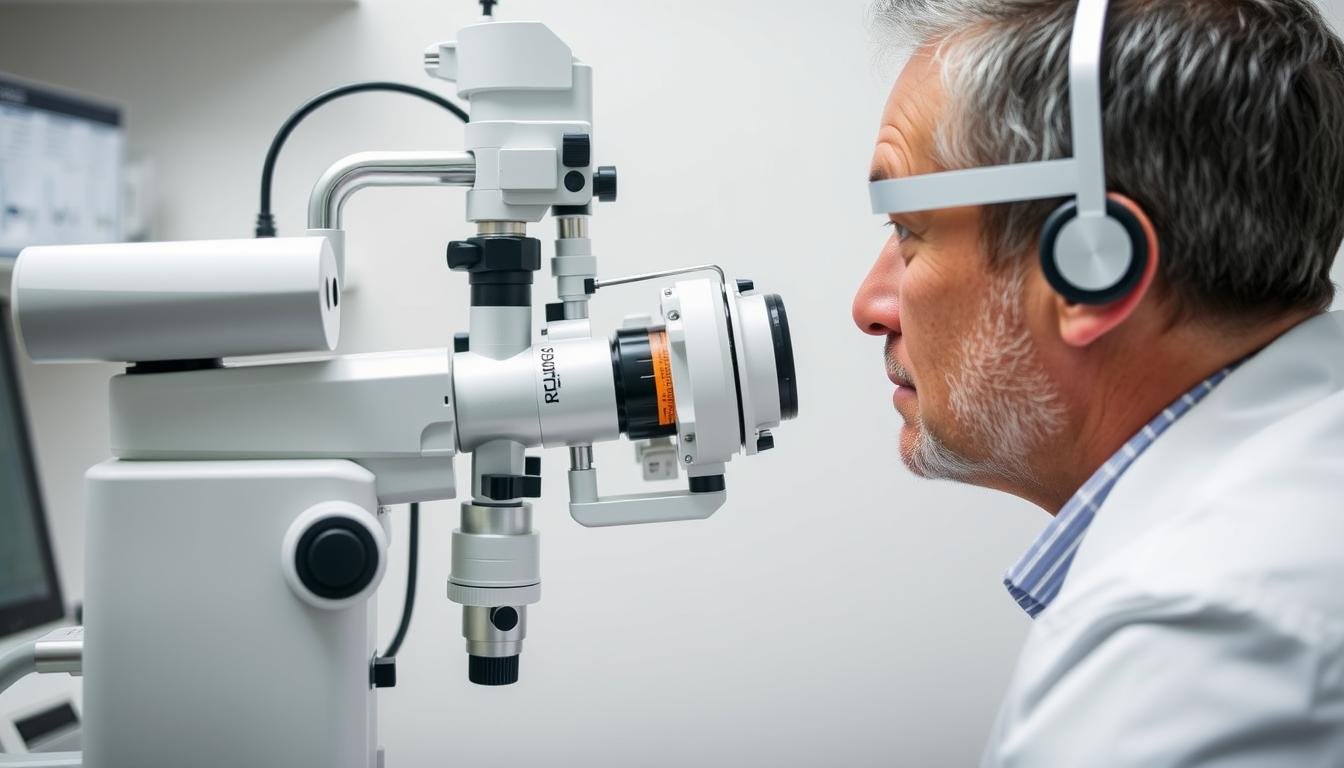
Modern ophthalmological examination differs from iridology analysis
Most medical organizations, including the American Academy of Ophthalmology, do not recognize iridology as a valid diagnostic method. However, some integrative health practitioners incorporate it as one component of a holistic health assessment rather than a standalone diagnostic tool.
Domande frequenti sui grafici dell'iridologia
How accurate are iridology charts in diagnosing health conditions?
The accuracy of iridology remains controversial. While practitioners report success in identifying health tendencies, scientific studies have produced inconsistent results. Most medical professionals consider iridology charts insufficient for medical diagnosis. They may provide insights into constitutional tendencies but should not replace conventional medical testing.
Can iridology charts detect serious conditions like cancer?
Responsible iridologists do not claim to diagnose specific diseases like cancer through iris analysis. Instead, they may identify areas of stress or weakness in body systems. Any concerning findings should prompt consultation with medical professionals for proper diagnostic testing.
I modelli di Iris cambiano nel tempo?
While the basic structure and color of the iris remain relatively stable throughout life, iridologists believe that certain markings can change to reflect health status. These changes typically occur gradually and may reflect long-term health conditions rather than acute issues.
Are all iridology charts the same?
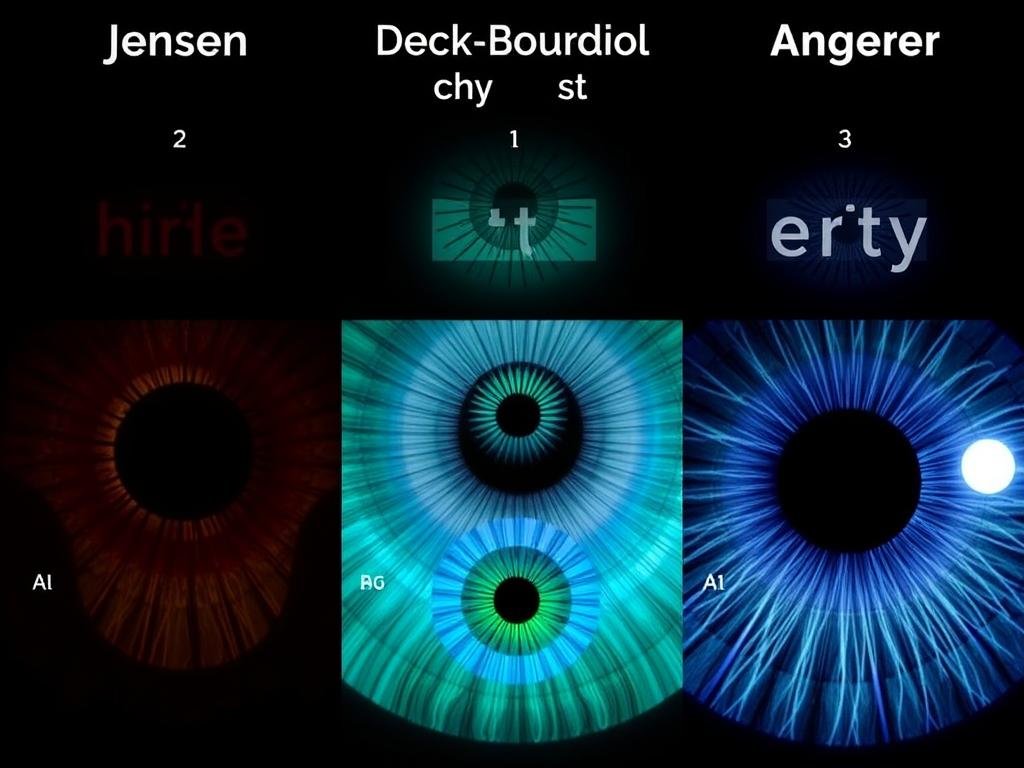
Comparison of three major iridology chart systems showing variations in mapping
Conclusione: il luogo delle carte d'iridologia nella valutazione della salute
Iridology charts represent a fascinating intersection of ancient observation and alternative health practices. While they continue to generate debate in medical circles, many people find value in the holistic perspective they offer.
Whether you approach iridology with enthusiasm or skepticism, understanding these intricate iris maps provides insight into a unique health assessment method with a long historical tradition. As with any health approach, balance is key—consider iridology as one potential tool in a comprehensive health strategy rather than a standalone diagnostic system.
For those intrigued by what their eyes might reveal, consulting with both conventional medical professionals and qualified iridology practitioners offers the most balanced approach to health assessment and maintenance.
Esplora ulteriormente l'iridologia
Ready to discover what your iris patterns might reveal about your health? Download our comprehensive guide and connect with certified practitioners.
Get Your Free Iridology Resource Kit






































